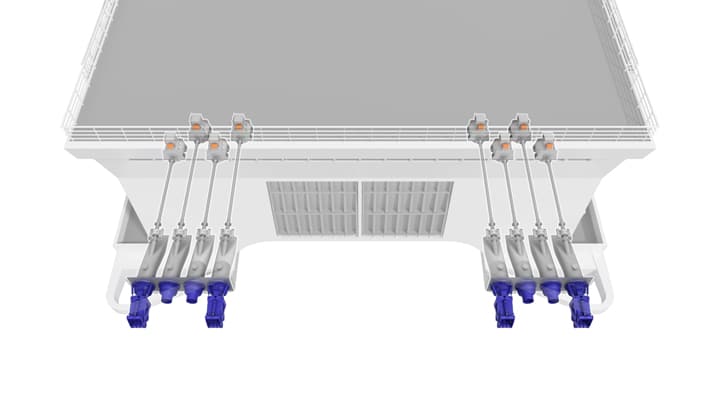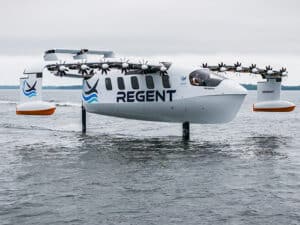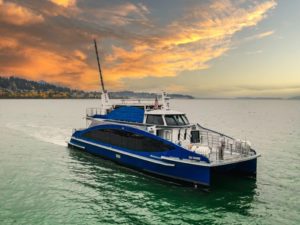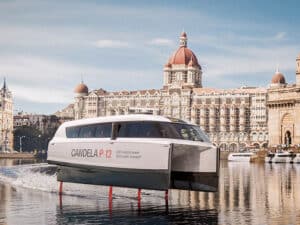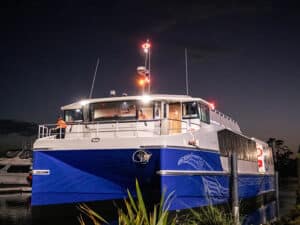
World’s largest battery electric vessel is set for 2025 delivery
Written by Nick Blenkey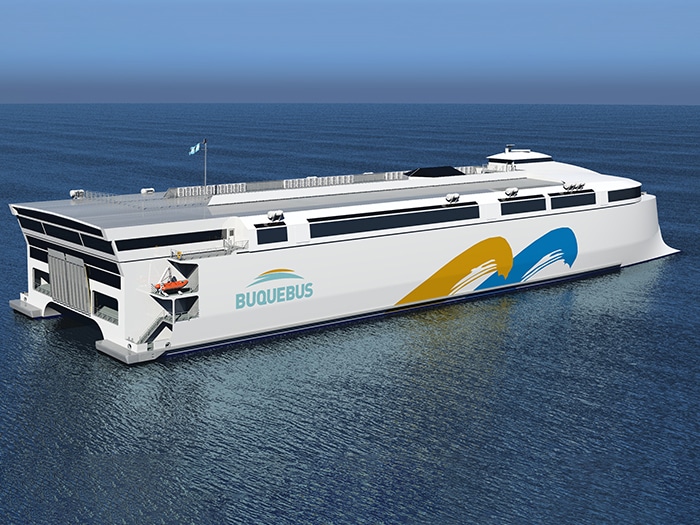
130 meter zero emission RoPax ferry will operate between Argentina and Uruguay.
Longtime Incat Tasmania customer Buquebús has now followed through on its plan to switch a 130 meter ferry under construction at the shipyard from LNG to all-electric propulsion. That means that the ship will be not only the world’s largest aluminum-hulled ship, but also the world’s largest battery electric vessel.
Set for delivery in 2025, Incat Hull 096 will operate between Argentina and Uruguay. It will have a capacity for 2,100 passengers and crew, 225 cars and will also include a duty free shop of over 2,000 square meters on the one level.
Incat Tasmania says that the interest in these battery electric ships is very positive and that it is now working toward the construction of its second, but smaller, battery-electric vehicle/passenger ferry.
“We are proud to be building in Tasmania this first in class ship for Buquebús who like us share a vision to be at the leading edge of low emission shipping in the world,” said Incat founder Robert Clifford. “Incat has always been an innovator and once again we are leading the world and the world is taking notice.”
“We are already increasing our workforce and have just finalized plans for the recruitment of at least another 200 employees over the next 12 months with the expectation that our workforce will more than double in coming years,” Clifford added.
“The build of the Buquebús ship is leading the world in this type of ship construction and will have leading edge technology in terms of zero emissions propulsion and storage systems. Once in operation the shore-side charging systems will have 50% more capacity than any current installation world-wide,” said Incat managing director Craig Clifford. He added that, in line with the Australian Federal Government’s plan for decarbonizing the economy, “100% renewable energy and net zero emissions have been achieved here in Tasmania we are ideally placed to build zero emission ships for the world right here.”
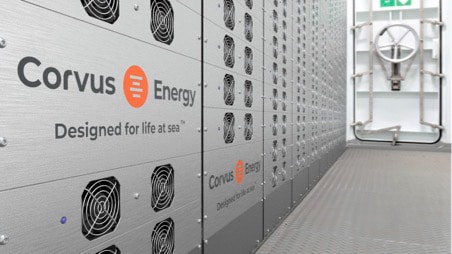
The switch to all-electric has brought Corvus Energy an order for what will be the largest battery system installed onboard a ship. With more than 40 MWh of energy storage, it will be four times as big as the current largest installation. The order for the ESS was awarded Corvus by Wärtsilä, the electrical system integrator for the vessel which will have e-motor driven Wärtsilä waterjets as its main propulsors.
The full Wärtsilä scope of supply includes Wärtsilä’s own energy management system, the power conversion system, DC shore charging system, the 40 MWh Corvus battery modules, the DC hub, the eight electric motors, eight Wärtsilä axial flow WXJ1100 waterjets, and the ProTouch propulsion control system. Delivery of the Wärtsilä equipment is scheduled for the latter part of 2024, and the vessel will be delivered in 2025.
“The overall high-efficiency of this next-generation ferry represents a game-changing advance in catamaran design,” said Roger Holm, president of Wärtsilä’s Marine Power business. “We are proud to have contributed our strong know-how in integrating our ship electrification solutions and propulsion equipment. The battery power pack that we are supplying will be the largest ever supplied, with a unique eight waterjet propulsor configuration. The eight e-motor waterjet propulsion configuration is the most efficient available on today’s market for this speed range and type application while boasting all the benefits from Wärtsilä’s axial flow waterjet technology – low weight, shallow draft, superb maneuevrability, and low maintenance.”
Corvus Energy says that the 40 MWh ESS has been made possible by its latest technological breakthrough– the lightweight battery, Dolphin NextGen. The design is based on the architecture of the four-year, multi-million dollar development program for the Corvus Blue Whale ESS. The Blue Whale development included a ground-up redesign that reevaluated and improved every aspect of battery design, including battery chemistry, mechanical and electrical design, and software building blocks. The Dolphin NextGen ESS, says Corvus, “is a game changer for marine battery projects due to its low weight and volumetric density, robustness, and unsurpassed flexibility.”
